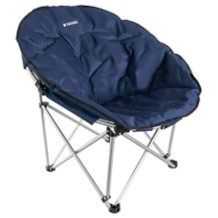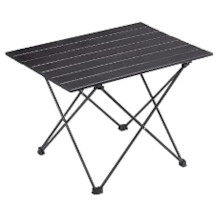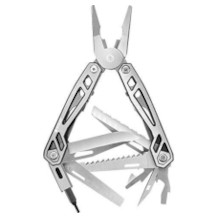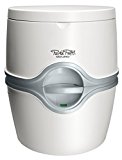Travel mug purchasing advice: how to choose the right product
- The most important facts in a nutshell
- Travel mugs keep your drinks hot or cold for several hours.
- They are suitable for long car journeys, trips into nature or lectures.
- Most travel mugs are made of stainless steel.
- The capacity of a travel mug is usually between 350 and 500 millilitres.
Keeping your drinks at the right temperature with a travel mug
A fresh coffee or tea is always good. However, hot drinks are not available everywhere and at all times. For such cases, travel mugs are ideal. They allow users to keep drinks either hot or cold for several hours and can be taken along at will. So you don’t have to do without your favourite drink and you even save money. It would be more expensive to buy a coffee to go instead.
Travel mugs are used in numerous areas. For example, you can use travel mugs to take your drink to school or university. This way, the coffee or tea stays warm for the entire lesson. In the café or canteen, you can refill the travel mugs as needed. If you want to avoid the coffee machine bottleneck in the office, they also come in handy.
Mugs like this are also very suitable for excursions. Whether you’re camping, hiking, barbecuing or having a picnic, you rarely make coffee anywhere in nature. So you’d better bring it with you so that coffee deprivation doesn’t spoil your outing. On hot days, a travel mug can also keep a cold drink at its temperature and offer you refreshment. Last but not least, a travel mug can enrich long car journeys. Whether you have to fight your way through a motorway traffic jam for hours or drive through the night, a coffee or tea will keep you awake and ensure that your mood doesn’t plummet.
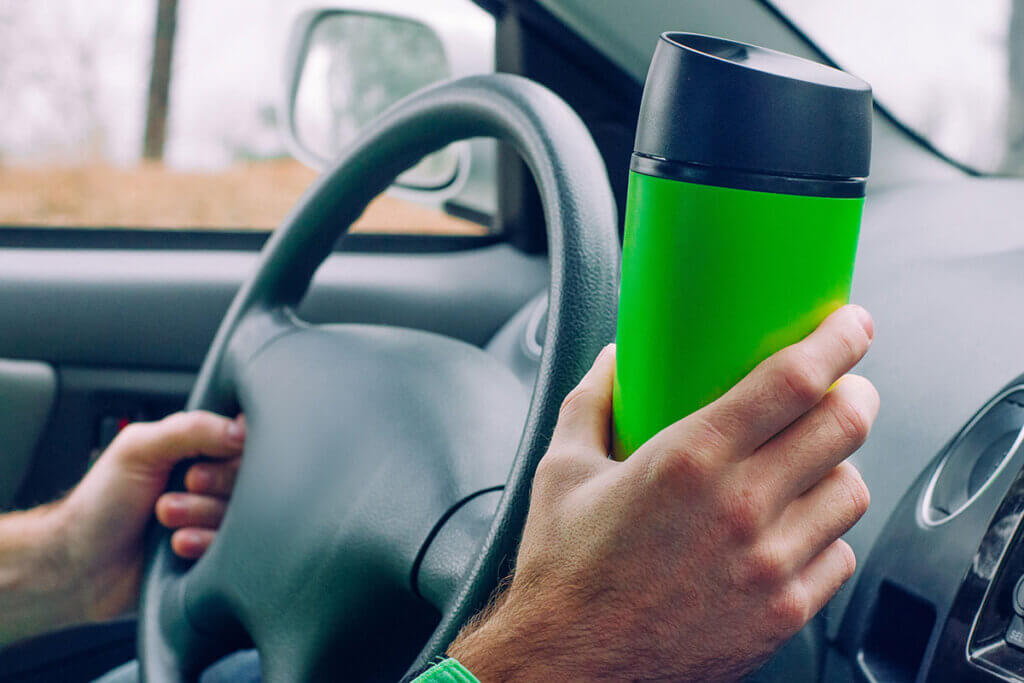
The anatomy of the travel mug
Externally, a travel mug looks very similar to a reusable drinking bottle. The outer shell can be made of plastic or ceramic, but it is usually made of stainless steel. Often a stainless steel outer shell is covered with plastic to make the grip surface and base non-slip.
Stainless steel is also often used for the inner container. Glass also keeps the temperature constant, but the material is too fragile and is therefore rarely used.
Between the inner container and the outer shell there is a vacuum, i.e. an area with no or hardly any air molecules. Thus, the heat cannot be conducted from the inside to the outside and the contents of the cup retain their temperature. This effect is sometimes reinforced by a mirror layer that reflects the heat radiation inside.
Furthermore, travel mugs come with a closure that serves to insulate the heat and prevent leakage. At the same time, the closure or lid functions as a drinking opening.
Some models even have a handle, which is good for handling. However, it can make transport more difficult, as not every cup holder or side pocket is designed for travel mugs with handles.
Travel mugs compared to other liquid containers
Travel mugs are not only very useful, but also particularly environmentally friendly. They often replace disposable paper and plastic cups, which are known polluters. The latter are not suitable for on-the-go use anyway, as they leak immediately when shaken slightly. Open cups and mugs are of course neither suitable for transport nor do they keep the contents hot or cold for long. Reusable drinking cups are also superior to travel mugs. In principle, the former are the sustainable version of common paper or plastic cups. They cannot close tightly because the lid has a small opening for drinking.
A travel mug differs from a thermos mainly in size. The choice between one and the other is therefore made on the basis of the required capacity.
A plastic or glass drinking bottle is no substitute for a travel mug. It does not insulate, but conducts the temperature outside. This means that the drink does not retain its temperature and the outer surface may become very hot or cold, which can lead to extremely unpleasant handling. Last but not least, plastic bottles can get microplastic particles into your drink.
Comfortable handling is a must
A high-quality travel mug must also score points in handling. Bulky mugs that are not easy to open or grip are extremely impractical.
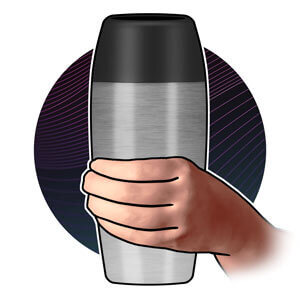
Secure grip
The shape, for example, is crucial for good handling. Models that are thick in the middle are difficult to grip. Bottle-shaped models that are a little narrower in the middle, on the other hand, fit well in the hand. A silicone coating is also a great help. This makes the cup non-slip, both on the standing surface and when gripping. With a handle, it is even easier to hold. A handy, non-slip handle prevents leakage and thus not only possible stains but also, in the worst case, burns.
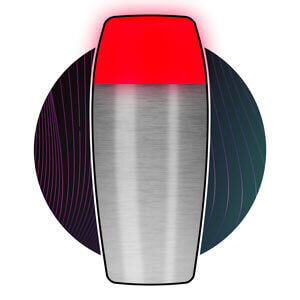
Lid type
When driving, you have at most one hand free. If this is your intended use, you should pay attention to the right type of lid. Lids with a turning screw, for example, are difficult to open with one hand. A hinged lever is much easier to operate with one hand. However, a lid with a push button is particularly practical. Ideally, this should even have a 360-degree drinking opening. That way, you don’t have to turn the cup upside down to drink from a particular opening.
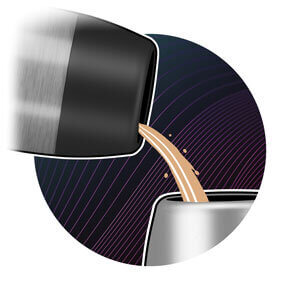
Drinking beam
To ensure a pleasant drinking stream, neither too much nor too little liquid should come out. Otherwise, in the worst case, you may get burns. A balanced drinking stream can also effectively prevent spillage. This is especially important when driving. After all, you are only using one hand in that case. In addition, you are looking at the road and therefore not paying attention to the lid opening. You must therefore be able to rely on the drinking stream flowing out constantly at the expected volume.
Weight
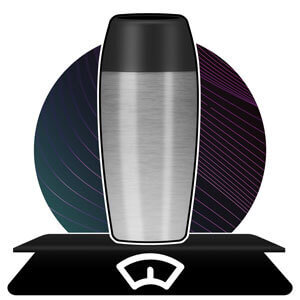
Weight
Last but not least, the weight plays an important role in handling, especially if you hold the mug with one hand. The weight of travel mugs when empty is usually between 250 and 450 grams. When completely filled, they can weigh almost one kilogram. Models made of plastic are significantly lighter than those made of stainless steel or ceramic. For most users, however, even full stainless steel travel mugs should not be too heavy. The high-quality material is therefore recommended despite its heavier weight.
An overview of common thermo cup materials
Most of the features of a travel mug depend on the material it is made of. These are mainly stainless steel, plastic and ceramic.
Stainless steel
Stainless steel is the most popular material for good reason. It is robust, durable and corrosion-resistant. When it comes to cleaning, the material is uncomplicated. Moreover, it does not affect the taste of the beverage. A vacuum provides very good thermal insulation. However, stainless steel models can be somewhat more expensive and heavier. Most stainless steel mugs cost between 10 and 20 euros. Often, travel mugs made of stainless steel are coated with plastic or, more rarely, with ceramic.
Advantages
- Robust
- Good insulation
- Durable
- Rustproof
- Easy to clean
- Food safe
Disadvantages
- Expensive
- Hard
Ceramic
Ceramic has an aesthetic added value for many, but it is not as practical as stainless steel. Although it is a good heat accumulator as a material, a ceramic mug cannot be compared with a vacuumed stainless steel mug. Ceramic mugs do, however, score points with very low heat conduction. This means that the outer surface of the mug does not heat up much even when the contents are very hot. In addition, ceramic is easy to clean and is corrosion-resistant and free of harmful substances. The biggest disadvantage of ceramic mugs is that they break very easily.
Advantages
- Stainless
- Relatively good heat storage
- Easy to clean
- Not heat conductive
- Pollutant-free
- Aesthetically pleasing
Disadvantages
- Fragile
- No vacuum: poorer heat retention
Plastic
Plastic scores mainly with a low price and easy cleaning. It is also the lightest material and corrosion-proof. In terms of thermal insulation, however, plastic cups do not fare well. They keep drinks warm for a much shorter time than, for example, models made of stainless steel. Plastic is not particularly robust, even if it can withstand a little more than ceramic. Last but not least, if the interior is made of plastic, there is a risk that harmful substances such as naphthalene will dissolve and be absorbed by you.
Advantages
- Inexpensive
- Easy
- Easy to clean
- Rustproof
Disadvantages
- Poor thermal insulation
- Not very robust
- Danger of pollutants
Other purchase criteria
The differences between travel mugs are not particularly serious for most models, as they are relatively simple household items. Nevertheless, there are a few things to consider before buying: Thermal insulation, for example, plays an important role. The material of the cup and the type of closure are decisive for temperature maintenance. In addition, users must be clear about the capacity of their mug before buying.
Thermal insulation
The heat retention time of a travel mug is usually about four hours. This refers to the time it takes for the temperature of the contents to drop from 90 to 60 degrees Celsius. The contents reach half of the initial temperature after about nine hours. However, these values can vary from model to model.
To keep the contents of a travel mug warm or cold for a long time, vacuum insulation is indispensable. This is usually present in stainless steel mugs. A vacuum is created between the inner and outer walls. Since there are no air molecules in this space, the heat is not or hardly transferred to the outside and the beverage retains its temperature. A mirror coating on the inside reinforces the insulation. However, the more often you open the lid, the more heat or cold escapes from the interior.
The lid and closure of the travel mug are crucial for insulation. Closures with a push-button or a turning screw insulate particularly well. With hinged levers, on the other hand, it can happen that the closure is or becomes leaky.
Although stainless steel has become widely accepted as the material for travel mugs, there are other materials that are used in their manufacture. A glass interior, for example, insulates particularly well, but is unsuitable for safety reasons. Plastic and ceramic are also sometimes used. Such models are double-walled, but do not insulate as well as vacuumed models made of stainless steel. A plastic or silicone jacket, on the other hand, benefits the insulation.
Leakage and breakage resistance
A travel mug that leaks is useless. After all, leaking not only leads to stains that are difficult to remove, especially with coffee, but can even cause minor burns. After all, the contents are almost boiling hot. Last but not least, leakage indicates that the mug is leaking, which impairs thermal insulation.
Furthermore, the mug must be unbreakable. Since travel mugs are often used on trips and journeys, there is a high probability that they will be exposed to knocks and falls. Besides thermal insulation, this is the main reason why stainless steel has become the common material for such mugs. After all, it is extremely robust. Models made of ceramic are much more fragile; they can break or even splinter even from slight impacts. Plastic is somewhat more durable than ceramic, but it is not as robust as stainless steel.
Capacity
The capacity of travel mugs is usually between 350 and 500 millilitres. Smaller models only hold 250 millilitres. There are also thermal mugs with an interior volume of considerably more than half a litre. In this case, however, we are talking more about thermos jugs.
Design and colour
Many users attach great importance to the design of their travel mug. After all, the mug accompanies them for a large part of their everyday life and is often carried in the side pocket of their backpack, where it is quite visible. In this case, it becomes part of their outfit. Often, travel mugs feature the characteristic stainless steel colour, combined with a black lid and possibly a black coating. But since the mugs are usually coated with plastic or silicone, they come in just about any colour. In addition, the outer shell may have patterns on it. For more unusual requests, you may have to expect an increased price.

Cleaning tips
Whether it is a stainless steel, ceramic or plastic mug, it rarely causes any trouble when it comes to cleaning, as it can usually be washed in the dishwasher as well as by hand. Of course, you should follow the manufacturer’s instructions in this regard before cleaning for the first time. It is also recommended that you clean the mug before using it for the first time. The only feature of a travel mug that could cause difficulties when cleaning is the lid. A lid with a lot of grooves and other hard-to-reach places is better cleaned by hand, as you can get to these places better that way. A removable lid makes cleaning much easier.

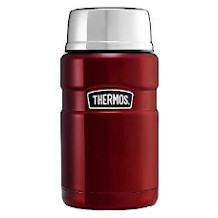
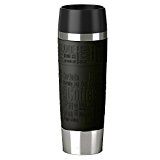
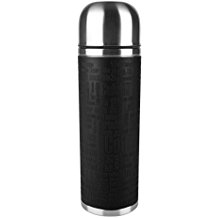
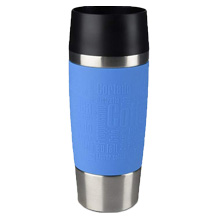














 13,683 reviews
13,683 reviews






